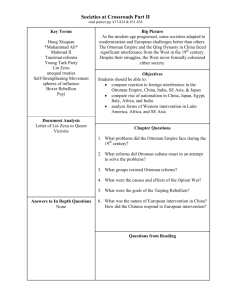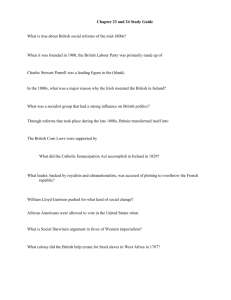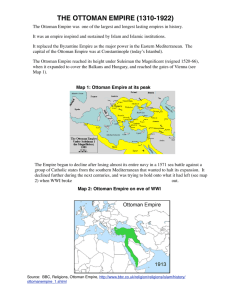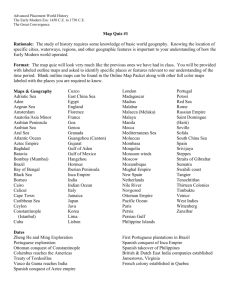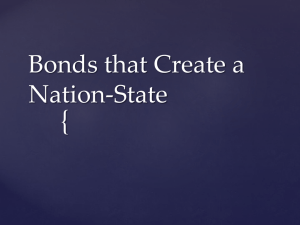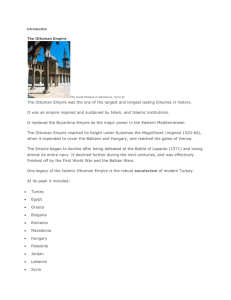Ottoman Empire - Scholar
advertisement
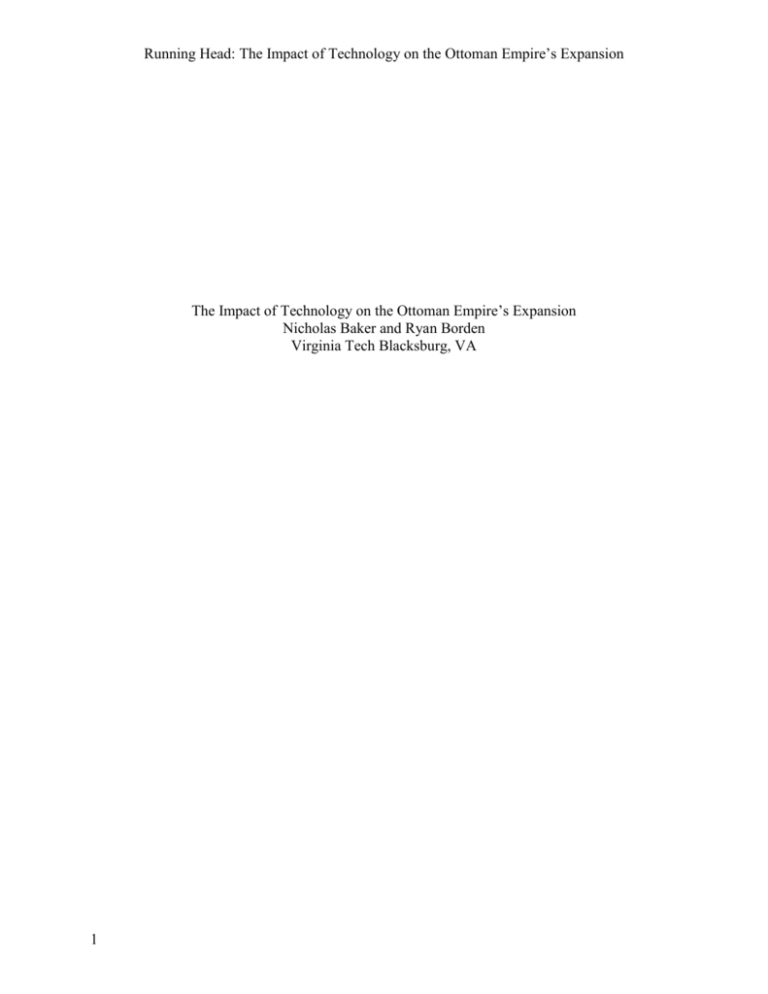
Running Head: The Impact of Technology on the Ottoman Empire’s Expansion The Impact of Technology on the Ottoman Empire’s Expansion Nicholas Baker and Ryan Borden Virginia Tech Blacksburg, VA 1 Running Head: The Impact of Technology on the Ottoman Empire’s Expansion Attachment A: PowerPoint with pictures of Constantinople for Just Do It Activity/Along with questions and directions. Attachment B: Rubric for Just Do It Activity Attachment C: The Ottoman Empire Expansion PowerPoint Presentation Attachment D: Worksheet for Map Activity Attachment E: Rubric for Map Activity Attachment F: Directions and Questions for Fishbowl/Think Pair Share Activity Attachment G: Rubric for Fishbowl/Think Pair Share Activity Attachment H: Directions and Terms needed for Visual Poster Activity Attachment I: Rubric for Visual Poster Attachment J: Copied text from World History Human Legacy. 2008 Pgs. 497-504 2 Running Head: The Impact of Technology on the Ottoman Empire’s Expansion Title: The Impact of Technology on the Ottoman Empire’s Expansion Lesson Author: Nicholas R. Baker and Ryan Borden Key Words: The Ottoman Empire, Osman I, Mehmed II or Mehmed The Conqueror, Constantinople, Istanbul, Byzantine Empire, Cannons, Janissaries, Ghazis, Millets, Dome, Suleyman I, Safavid Empire, Battle of Chaldiran, Seljuk Turk Empire, Sultan, 1453 Fall of Constantinople, Sinan. Grade Level: 10-12 Time Allotted: 1hr 45 minutes (1 block) Rationale/ Purpose (so what?) Nature and scope of topic. Why is this significant to the mission of educating future citizens? Our topic is of great importance because it had a significant impact on the geopolitical landscape of the world. Asia Minor and the Ottoman Empire were greatly impacted as a whole by technological changes related to the Ottoman Empires expansion. It also covers certain sections of the SOL that will be covered later in the lesson plan. Background/Context: How does this lesson fit into a unit of study? Looking backwards, looking forwards This lesson will take place during the discussion on various Asian Empires. This discussion would likely take place when introducing the Ottoman Empire after discussing the Mughal Empire last class. Key Concept(s) include definition: The Ottoman Empire: Formed under Osman I who became the empire’s first sultan. Osman I essentially united the nomadic tribe of the ghazis and formed the foundation of the Ottoman Empire. The term Ottoman was given by Westerners that represented the descendants of Osman I. Osman I: First sultan of the Ottoman Empire that united the nomadic ghazi tribes. Osman I essentially founded the Ottoman Empire. Mehmed II or Mehmed The Conqueror: Mehmed II was a prominent sultan who was responsible for defeating Constantinople (the capital for eastern Christianity) and eradicating the Byzantine Empire. Mehmed 3 Running Head: The Impact of Technology on the Ottoman Empire’s Expansion became known as Mehmed the Conqueror after his defeat of the Byzantine Empire. Mehmed II used canons to batter the cities wall for two months. This was a major technological achievement that was utilized by the Byzantine Empire. Mehmed was also responsible for essentially rebuilding Constantinople into an Islamic city known as Istanbul. Constantinople/Istanbul: Constantinople was the capital of the Byzantine Empire. Constantinople was a major trade hub between the Mediterranean Sea and Black Sea. The city of Constantinople fell in 1453 when Ottoman Forces conquered the city. The city was rebuilt into an Islamic city known as Istanbul. Byzantine Empire: The Byzantine Empire was essentially the Eastern Roman Empire. Cannons: Cannons are massive weapons that were designed to take out heavily fortified cities and cause massive damage on enemy combatants. Janissaries: Captured Christian boys taken from conquered areas to serve as the sultans bodyguard/ personal troops. Noted for their use of gunpowder weapons. Ghazis: Nomadic people who were considered the “Warriors for Islam.” Millets: Religious communities that were formed for non-Muslims. They were able to follow their own laws and chose their own leader. Suleyman I: Naval expansion of the Ottoman Empire. Carried out many domestic reforms, reformed tax systems, and etc. He ruled at the height of the Ottoman Empire. The Ottoman Empire expanded into Syria, Egypt, North Africa, and conquered Mecca and Medina. Safavid Empire: Persian based empire that originated in Iran. The Safavid Empire was defeated due to the Battle of Chaldiran where the Ottoman Empire wiped them out. Battle of Chaldiran: This battle essentially led to the defeat of the Safavid Empire by the Ottoman Empire. Seljuk Turk Empire: Existed prior to the Ottoman Empire. Turkey split up and created independent states. Sultan: or leader/ruler. 1453 Fall of Constantinople: Important event that saw the demise of the Byzantine Empire by the Ottoman Empire ruled by Mehmed II. The siege of Constantinople took place over a two month period between April and May of 1453. Landmark siege that saw the use of the cannon to take out Constantinople’s land walls. 4 Running Head: The Impact of Technology on the Ottoman Empire’s Expansion Sinan: designer of the Mosque of Suleyman I. He invented technological achievements in architecture by combining the dome with rectangular structure buildings. Asia Minor: General region that the Ottoman Empire originated in. Modern day area of Turkey. Venetian Empire: Helped the Ottoman Empire conquer the Byzantine Empire during the Fall of Constantinople in 1453. The Venetian Empire essentially was dominant over the sea during the battle using Greek Fire for one of the first times in history. Greek Fire: is a device that the Venetian Naval force placed on the bow of their ships. Some sort of flammable material was launched from this device and then they would set this material on fire. Essentially, modern day flame thrower. NCSS Standard(s) SOL Information *As written in the Virginia SOL “Curriculum Framework” for the grade level NCSS Theme (s) with indicators: Theme VIII: Science, Technology, and Society (a) Science, and its practical application, technology, have had a major influence on social and cultural change, and on the ways people interact with the world. Scientific advances and technology have influenced life over the centuries, and modern life, as we know it, would be impossible without technology and the science that supports it Explanation: The Ottoman Empire’s use of military technology greatly impacted their ability to expand so fast and efficiently over time. These military technological advances such as the invention of the use and invention of the cannon used by Mehmed II to take out cities fortified by massive walls that surround the city. The technological advance and application of the cannon essentially was one of the major factors that led to the expansion of the Ottoman Empire. The Ottoman Empires expansion and eventual 5 Running Head: The Impact of Technology on the Ottoman Empire’s Expansion conquest of Constantinople significantly altered the entire Asia Minor region, North Africa, and various other territories that were conquered by the Ottoman Empire. (b) There are many questions about the role that science and technology play in our lives and in our cultures. What can we learn from the past about how new technologies result in broader social change, some of which is unanticipated? Is new technology always better than that which it replaces? How can we cope with the ever-increasing pace of change, perhaps even the concern that technology might get out of control? How can we manage technology so that the greatest numbers of people benefit? How can we preserve fundamental values and beliefs in a world that is rapidly becoming one technology-linked village? How do science and technology affect our sense of self and morality? How are disparate cultures, geographically separated but impacted by global events, brought together by the technology that informs us about events, and offered hope by the science that may alleviate global problems (e.g., the spread of AIDS)? How can gaps in access to benefits of science and technology be bridged? Explanation: For this lesson we are tying changes in technology to territorial expansion. The Ottoman Empire was able to use advances in gunpowder technology to expand their territories and alter the balance of power throughout the entire region of Asia Minor, North Africa, and the Arabian region. The balance of power in these areas were greatly affected by the Ottoman Empire and its technological advances. SOL*: World History & Geography 1500 – Present STANDARD WHII.5a The student will demonstrate knowledge of the status and impact of global trade on regional civilizations of the world after 1500 A.D. (C.E.) by a) describing the location and development of the Ottoman Empire. STANDARD WHII.5a The student will demonstrate knowledge of the status and impact of global trade on regional civilizations of the world after 1500 A.D. (C.E.) by a) describing the location and development of the Ottoman Empire. 6 Running Head: The Impact of Technology on the Ottoman Empire’s Expansion Essential Knowledge Essential Skills (minimum for SOL Resource Guide) Original location of the Ottoman Empire • Asia Minor Expansion and extent of the Ottoman Empire • Southwest Asia • Southeastern Europe, Balkan Peninsula • North Africa (minimum for SOL Resource Guide) Use maps, globes, artifacts, and pictures to analyze the physical and cultural landscapes of the world and to interpret the past. (WHII.1b) Identify and compare contemporary political boundaries with the locations of civilizations, empires, and kingdoms. (WHII.1d) Development of the Ottoman Empire • Capital at Constantinople renamed Istanbul • Islamic religion as a unifying force that accepted other religions • Trade in coffee and ceramics Guiding Question(s): MUST BE SHARED WITH STUDENTS AT BEGINNING OF EACH LESSON- Visible in lesson procedure and materials. The day’s big question: How did the various technological advancements contribute to the expansion of the Ottoman Empire? (Sub-Question: In what ways did technological advancements contribute to the expansion of the Ottoman Empire? How did this alter the entire region?) 7 Running Head: The Impact of Technology on the Ottoman Empire’s Expansion Lesson Objective(s): clearly emerges from big question and rationale and standards and will align with your assessment in Procedure and Process Obj. 1 Students will be able to analyze and study the Fall of Constantinople in relation to their knowledge of key terms and ideas related to the expansion of the Ottoman Empire and how it was able to expand using technological advances in military tactics and the introduction of gunpowder weaponry. Obj. 2 Students will be able to map important locations within the Ottoman Empire and will be able to map its expansion. Obj. 3 Students will be able to analyze, summarize, and construct a poster using historical evidence to illustrate how the Ottoman Empire was able to expand using technological advances during the time period. (Assessment): By the end of the lesson students will be able to analyze and determine the progression and impact of technology specifically gunpowder weaponry such as the musket and cannon on the rapid effective massive expansion of the Ottoman Empire. Assessment Tool(s) to be used- Everything above- goes to what you want them to know/understand do- So what assessments are you going to use to help you manage and monitor that they have got it-informal and formal—make one over-riding assessment connect to your closure. Assessment 1. Just Do It Activity: Visual discovery responding to a question through written assessment. Understanding monitored through instructors proximity control. This activity is where students will look at two pictures of Constantinople and list several issues that an invading force would have to take the city and explain why the city was strategically located between the Mediterranean Sea and the Black Sea. As a class the instructor will discuss with students what they came up with during the Just Do It Activity. Assessment 2. Mapping Activity. Students will map important locations such as Asia Minor, Turkey, Constantinople/Istanbul, the Mediterranean Sea, the Black Sea, the Byzantine Empire, the 8 Running Head: The Impact of Technology on the Ottoman Empire’s Expansion Safavid Empire, and etc. Students will map the expansion of the Ottoman Empire under the three sultans Osman I, Mehmed II, and Suleyman I. Assessment 3. Think Pair Share and Fishbowl Discussion: I want students to discuss how Mehmed II was able to expand and conquer the Byzantine Empire using the technological advances of gunpowder weaponry. During this activity I want students to analyze why gunpowder weaponry is important and how it ties to the expansion of the Ottoman Empire and its impact on the Empire as a whole. Assessment 4. Wrap Up: Students will be able to creatively summarize the lessons major points by building and creating a poster illustrating how the use of gunpowder weapons such as muskets and Mehmed’s cannons, architecture, and various technological advances had a significant impact on the Ottoman Empire and its ability to expand. Emphasis will be on students’ knowledge and application of key terms discussed during lecture such as Janissaries, Ghazis, Millets, and etc. 9 Running Head: The Impact of Technology on the Ottoman Empire’s Expansion Materials: Historical Source(s): List here and include copies in materials section below Additional Materials/Resources: List here and include copies in materials section- textbooks etc page numbers, websites etc Images for Ottoman Empire PowerPoint including map from map activated retrieved from Google Images Ramirez, S., Stearns, P., and Wineburg, S., World History Human Legacy Teachers Edition. Holt Rinehart Winston 2008 Pgs.: 497-504 10 Running Head: The Impact of Technology on the Ottoman Empire’s Expansion Procedure/Process: 1) JUST DO IT! The “Hook”: A high-interest activity that introduces new content with connections to students’ prior knowledge. Between 1-5 minutes. You could also introduce the days guiding question- could help with assessment of student needs The Hook: The instructor presents several pictures of Constantinople and has students describe and explain several issues that a military force would come across when invading a city. This will help students to realize the importance later on during the lesson on the use of gunpowder weaponry. 2) Instructional sequence: Processing Activity and Procedure – Obj # See above. include directions, question frames, assignment details, to be given to students (these should all be made into explicit materials (e.g. see material A) Do you have opportunities for direct/guided instruction and independent practice/engagement when appropriate and time estimates Check for Evidence of Understanding -Either Formal or Informal e.g. assessments- question frames, quiz, choice activities, discussion with frame and your THAT’s A WRAP. (Checks Essential Knowledge and Skills should be in line with assessment tools above) Time Allotment: 5 minutes Instructors will monitor students and provide guidance if necessary. (See Attachment B) Instructors will ask students to turn in their responses at the end of the activity. Instructor starts PowerPoint slideshow with several pictures of Constantinople. (See Just do it. Attachment A) Instructor will ask students to take out a piece of notebook paper and a pencil or pen to answer the following question, “What possible issues would an invading force encounter when trying to conquer the city of Constantinople?” Instructor will introduce the topic of the day as well as the big questions Transition: and the learning objectives. Instructor will then start PowerPoint slideshow presentation. Time Allotment 5-10 minutes (See Attachment C) Time Allotment: 10-20 minutes Instructor will walk around the room and make sure that students are on task and that To ensure students will achieve or grasp they complete their Objective objective one instructor will facilitate a worksheet. Instructor will ask #1 map activity after introducing the ghazis, the Ottomans, and Osman I. Instructor will them to turn in their activity at the end of the activity. hand out the map activity worksheet and (See Attachment E) have students answer the questions that 11 Running Head: The Impact of Technology on the Ottoman Empire’s Expansion the worksheet asks. (See Attachments D) Transition: The instructor will continue the PowerPoint presentation and complete the entire presentation/lecture. Time Allotment: 20-30 minutes Time Allotment: 10-15 minutes Objective #2 To ensure students will achieve or grasp objective two the instructor will facilitate a fishbowl/think pair share activity with students. The instructor will ask students to discuss and answer questions on how Mehmed II was able to expand and conquer the Byzantine Empire using the technological advances of gunpowder weaponry. During this activity the instructor will want students to analyze why gunpowder weaponry is important and how it ties to the expansion of the Ottoman Empire and its impact on the Empire as a whole. (See Attachment F) Instructors will then engage students in a fishbowl discussion activity where students will discuss how the invention of new technologies impacted the Ottoman Empire’s ability to expand so rapidly and effectively. Students will discuss as a class the two questions on worksheet. (See Attachment F) Instructors will guide and observe students and facilitate the overall group discussion. Students will turn in their think pair share responses after the activity. (See Attachment G) 3) Closure- THAT’S A WRAP that goes to opening question- and also in part to assessment tools –at least one key assessment tool. (Do you need a rubric) (Covers Objectives #3 and 4): Time Allotment: 10-15 minutes Instructors will ask students to be able to creatively summarize the lessons major points by building and creating a poster illustrating how the use of gunpowder weapons such as muskets and Mehmed’s cannons, architecture, and various technological advances had a significant impact on the Ottoman Empire and its ability to expand. Emphasis will be on students’ knowledge and application of key terms discussed during lecture such as Janissaries, Ghazis, Millets, and etc. (See Attachment H and I) 12 Running Head: The Impact of Technology on the Ottoman Empire’s Expansion Modifications/Accommodations for Diverse Learners: Include reference and acknowledgement of IEP plans for specific students- that is easy. Additionally, highlight how you have designed materials/sequences that pay attention to preassessment evidence to address readiness, interest, and learning preference needs, including attention to student groupings, use of time and materials, variance in whole class and small group instruction, varied task complexity. Can you delineate key instructional strategies and scaffolds that are effective for responding to student needs? Do you provide rubrics to explain what good work looks like? Do you provide room for direct instruction/guided instruction (including read alouds and think alouds), independent practice. (Use Cruz and Thornton, and Tomlinson and McTighe). Differential Instruction by taking into account the learning process, learning modalities, critical literacy levels, and critical thinking abilities. Multiple types of activities adhering to different learning modalities (Visual, Body Kinsthetic, Auditory, and Written). Instructors will provide scaffolding through the Just Do It Activity and Fishbowl Activity. Instructors will promote critical literacy and thinking skills See Case Manager for Student (s) 13 Running Head: The Impact of Technology on the Ottoman Empire’s Expansion Materials (one resource per page- so it becomes a teacher or student handout, or overhead directions or ppt presentation. Include photocopies if need be. Can you provide elements of choices in materials or enrichment or support/anchor materials for different students?. 14


